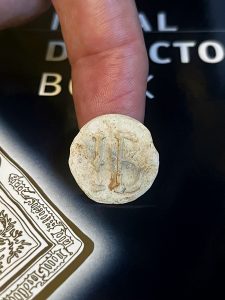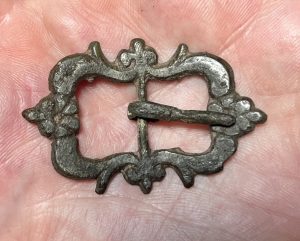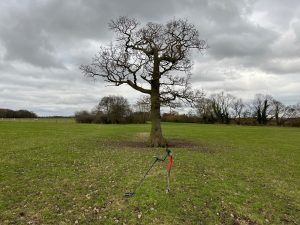
There’s something magical about the moment when your metal detector signals a find, and you unearth a piece of history from the soil. I don’t know about you, but I absolutely love finding silver hammered coins. The excitement of holding a piece of currency that last saw daylight centuries ago never gets old. It’s a connection to our past that few other hobbies can provide, and it’s what keeps me coming back to the fields time and time again.
Choosing the Perfect Spot for Metal Detecting
It was a warm August afternoon when I decided to head over to a couple of fields where I had permission for some metal detecting. The sun was high in the sky, casting long shadows across the lush green grass. I could feel the anticipation building as I packed my gear into the car. The familiar weight of my detector, the rattle of my digging tools, and the crinkle of my finds bag all added to the excitement.
The two fields I had in mind are of similar size, connected by two open gaps that allow tractors to pass through. Currently, they’re just grassed pasture, primarily used for growing and cutting grass to feed livestock. One field runs alongside a small lane leading to an old church, its weathered stones telling tales of generations past.
Choosing the right location is crucial in metal detecting, especially when you’re hoping to find silver hammered coins. Historical maps, old documents, and local knowledge can all provide clues about promising areas. I always do my research before heading out, looking for sites of old settlements, trade routes, or battlefields.
The Familiar Field: A Trove of Historical Treasures
We’ve searched the field by the church quite extensively over the years, and it’s yielded some fascinating finds. From Celtic coins to medieval buckles, this patch of land has been generous in sharing its secrets. Each discovery has added another piece to the historical puzzle of our local area.
One of my favorite finds from this field was a beautiful silver shilling from the reign of Charles II. It was minted in London and still bore clear details of the king’s portrait. Finds like these make you realize just how much history is lying beneath our feet, waiting to be rediscovered.
Identifying historical sites for metal detecting requires a combination of research skills and intuition. I often start by studying old maps of the area, looking for signs of former settlements or important routes. Local history books and archaeological reports can also provide valuable information. Sometimes, even the name of a field can give clues – names like “Castle Field” or “Roman Close” can be indicators of past activity. The best locations for metal detecting medieval silver coins are of course where a lot of medieval activity took place, so locations close to medieval manor houses and medieval churches are perfect.
The Challenging Second Field: A Test of Perseverance
The other field, however, has been a different story altogether. Despite numerous attempts, it’s given us nothing but a few 20th-century pre-decimal coins and some fairly uninteresting buttons. But as any seasoned detectorist knows, persistence is key. I decided to give this second field another chance, hoping that today might be the day it finally reveals its hidden treasures.
It’s important to remember that even seemingly unproductive fields can surprise you. Sometimes, it’s just a matter of hitting the right spot or searching under the right conditions. Factors like recent plowing, rainfall, or even the angle of the sun can affect your chances of making a good find.
Hours of Searching: When Patience Wears Thin
As I swept my detector back and forth across the stubborn field, the familiar beeps and boops filled the air. But alas, nothing interesting was coming up at all. After a couple of hours of detecting with nothing much to show for it, I could feel my enthusiasm waning. The weight of the detector seemed to grow heavier with each passing minute.
It’s during these moments that many beginners might give up. But experience has taught me that perseverance often pays off in this hobby. I’ve lost count of the number of times I’ve made a significant find just as I was about to call it a day.
Staying motivated during unproductive sessions can be challenging, but there are several strategies and tips for staying motivated during unproductive metal detecting sessions help me to push on:
- Set small goals: Instead of focusing on finding valuable items, set goals like covering a certain area or digging a specific number of signals.
- Appreciate the outdoors: Take time to enjoy the fresh air, scenery, and wildlife around you.
- Learn from each signal: Use less productive days to improve your skills in identifying different types of signals.
- Socialize: If possible, detect with a friend. Sharing experiences can keep motivation high.
- Remember past successes: Keep in mind that every detectorist has dry spells, and your next great find could be just around the corner.
A Change of Scenery: Returning to Familiar Ground
With a sigh, I decided to head through one of the tractor gaps back into the first field. I wasn’t expecting much because we had pretty much covered it from top to bottom in previous outings. However, I thought to myself, “It can’t be any worse than that previous field,” so I set out making my way across it.
The signals were few and far between, with nothing that caused me to stop and investigate any further. The sun had begun its descent, casting a golden glow across the field, and I was beginning to think about calling it a day.
As I walked, I reflected on the history of this area. The nearby church dated back to the Norman period, and I knew that people had been living and working this land for centuries before that. Each step I took could be covering a lost coin, a dropped tool, or some other relic of the past.
The Moment of Discovery: A Silver Sixpence Reveals Itself
Then suddenly, there it was – a lovely crisp signal with a steady number on the display. My heart skipped a beat, but I tried not to get too excited. After all, I’d had my fair share of disappointments today.
I carefully dug a plug out and flipped it over, my movements practiced and precise. Reaching for my pinpointer, I began to scan the hole. To my surprise, the find was in the wall of the hole that I had dug. My pinpointing with my detector must have been a bit off. Somehow my spade hadn’t even touched it – I don’t know how, but it must have missed by a fraction of a millimetre.
Accurate pinpointing is crucial in metal detecting, not only to find your target quickly but also to minimize damage to both the artifact and the surrounding area. Here are some techniques for accurate pinpointing in metal detecting that I find useful:
- Use a cross-sweeping technique: Sweep your coil in an “X” pattern over the signal to narrow down its location.
- Reduce your detector’s sensitivity: This can help you pinpoint more accurately in mineralized soil.
- Use a dedicated pinpointer: These handheld devices can precisely locate a target in a plug or hole.
- Practice with known targets: Bury some objects in your yard and practice locating them to improve your skills.
- Listen to the audio: Many detectors produce different tones as you get closer to the target.
A Glimpse into Tudor England: Elizabeth I’s Silver Sixpence
With trembling fingers, I reached down and picked up a lovely little hammered silver sixpence. As I turned it over in my hand, I could make out the date: 1567. My breath caught in my throat as I realized I was holding a coin from the reign of Elizabeth I, the Virgin Queen herself.
The coin was remarkably well-preserved, considering it had spent over 450 years in the ground. I could make out the profile of Elizabeth, her elaborate ruff collar just visible around her neck. On the reverse, the Tudor rose stood proud, a symbol of the dynasty that had shaped England’s destiny.
The Lessons of Metal Detecting: Patience and Persistence Pay Off
As I stood there, marveling at my find, I couldn’t help but reflect on the day’s events. It just goes to show that no matter how much you think a field is done, it’s always worth another go sometime. Metal detecting is as much about persistence and patience as it is about skill and equipment.
This find was a perfect example of why we should never give up on a site too quickly. Even well-searched areas can still yield surprises. Factors like soil erosion, plowing, or even frost heave can bring buried objects closer to the surface over time.
Preserving the Past: Caring for Silver Hammered Coins
Once I got home, I carefully cleaned the coin using proper conservation techniques. It’s crucial to handle these delicate artifacts with care to preserve them for future generations. I took several photos to document the find and add it to my growing collection of discovered treasures.
Cleaning and preserving silver hammered coins requires a delicate touch. Here are some guidelines on how to clean silver hammered coins:
- First off only clean them if you really have to, if you feel that you need to then avoid harsh cleaning methods: Never use abrasive materials or chemicals.
- Use distilled water: Tap water can contain chemicals that may damage the coin.
- Gentle brushing: A soft-bristled brush can remove loose dirt.
- Air drying: Pat the coin dry with a soft cloth and allow it to air dry completely.
- Storage: Store the coin in a non-PVC holder in a cool, dry place.
- Handling: Always handle the coin by its edges to avoid transferring oils from your skin.
- Professional conservation: For valuable or fragile coins, consider seeking help from a professional conservator.
The Historical Context: Elizabeth I’s England
Finding a coin from Elizabeth I’s reign provides a tangible link to one of the most fascinating periods in English history. The 1560s were a time of relative stability after the religious turmoil of the previous decades. Elizabeth had established herself on the throne and was steering a careful course between the Catholic and Protestant factions in her kingdom.
In 1567, the year my coin was minted, Elizabeth would have been 34 years old and at the height of her powers. The Spanish Armada was still two decades in the future, and England was entering a golden age of exploration, literature, and the arts.
Reporting the Find: The Importance of Responsible Detecting
As with all significant finds, I made sure to report this coin to our local Finds Liaison Officer (FLO) as part of the Portable Antiquities Scheme. This is an essential part of responsible metal detecting, as it helps build our understanding of local and national history.
The FLO was excited about the find and provided me with more information about similar coins found in the area. This data helps archaeologists and historians build a picture of coin circulation and economic activity in Tudor England.
Conclusion: The Endless Adventure of Metal Detecting
As I sit here writing this, the silver sixpence sits on my desk, a tangible connection to the past. It serves as a reminder of why I love this hobby so much. Every time I head out with my detector, there’s the possibility of uncovering a piece of history, of holding in my hands something that hasn’t seen the light of day for centuries.
This hobby has taught me so much – not just about history, but about patience, perseverance, and the thrill of discovery. It’s given me a deeper appreciation for the land around me and the countless generations who have walked it before.
So, don’t get discouraged by unproductive sessions. Keep searching, keep exploring, and who knows? Your next big find might be just a signal away. The fields are waiting, full of secrets yet to be uncovered. Happy hunting!
It just goes to show that no matter how much you think a field is done it is always worth another go sometime. Here are a few much photos of it.



If you like my content and want to see more, why not subscribe using the subscribe option at the bottom of the page. It doesn’t cost you anything, it just means that I can email you to let you know when I publish a new post or article. Thanks




